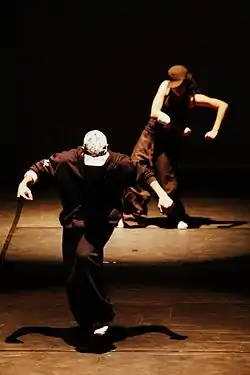Street dance
A street dance is a dance style that evolved outside dance studios in any available open space. This includes streets, dance parties, block parties, parks, school yards, raves, and nightclubs due to the fact that the African American and Latino people who created the style in the late 1960's and early 1970's were not accepted into dance studios because of their race. A street dance is a vernacular dance in an urban context.[1] Vernacular dances are often improvisational and social in nature, encouraging interaction and contact with spectators and other dancers. These dances are a part of the vernacular culture of the geographical area that they come from. Examples of street dance include b-boying (or breakdancing), which originated in New York City.[2]

Street dance is an umbrella term for a large number of social dance styles. Social dance styles have many accompanying steps and foundations, created organically from a culture, a moment in time, a way of life, influenced by natural social interaction.[3]
Clogging, which evolved in the streets and factories of Northern England in the mid-19th century, is an early form of street dance.[4]
See also
- List of street and vernacular dances
- List of ethnic, regional, and folk dances sorted by origin
References
- Stearns, Marshall Window; Stearns, Jean (1994). Jazz Dance: The Story of English and American Vernacular Dance. New York City: Da Capo Press. ISBN 0306805537.
- Mansbach, Adam (24 May 2009). "The ascent of hip-hop: A historical, cultural, and aesthetic study of b-boying". Boston.com. Retrieved 18 September 2010.
- "Street Dance Classes Harlow". 16 June 2020. Retrieved 16 June 2020.
- Hickling, Alfred (2 December 2010). "Clog dancing's big street revival". The Guardian. Retrieved 1 December 2019.
External links
 Media related to Street dance at Wikimedia Commons
Media related to Street dance at Wikimedia Commons
| Look up street dance in Wiktionary, the free dictionary. |